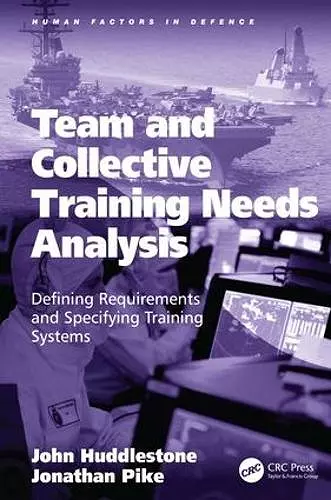Team and Collective Training Needs Analysis
Defining Requirements and Specifying Training Systems
Jonathan Pike author John Huddlestone author
Format:Hardback
Publisher:Taylor & Francis Ltd
Published:17th Dec '15
Currently unavailable, and unfortunately no date known when it will be back
This hardback is available in another edition too:
- Paperback£80.99(9781138092150)

Military capability is delivered operationally at a team and collective level, be it a unit as small as a squad or section, or as large as a maritime task group. Modern military forces are required to deal with a potentially wide range of missions frequently involving multiple alliance partners, within a geopolitical environment which can seem to change rapidly. Individual performance, while being important, is not the primary determinant of mission success - force integration, interoperability, adaptability and teamwork are key factors. Team and collective training which fully addresses these factors is fundamental to the development and delivery of military capability. As a consequence, the requirement to determine training requirements and specify effective systems for the delivery of team and collective training is critical to operational success.
Training Needs Analysis (also known as Front End Analysis), is a well-established methodology for analysing training requirements and specifying training solutions used extensively by the UK and its NATO partners. However, the analytical techniques employed are optimised for individual training, with little guidance being offered on its application in the team and collective context. Team and Collective Training Needs Analysis (TCTNA) has been developed to close this methodological gap. It addresses the issues of the relationship of individual and team tasks, teamwork, command and control, task and training environments, scenario definition, instructional strategy, team training approaches, instructional functions, and wide-ranging organisational and procurement considerations.
Part One of the book develops an integrated set of models which underpin the analytical approach presented in Part Two. Worked examples and case studies illustrate the application of the approach. Between 2005 and 2015 the authors worked on numerous training-related research projects at Cranfield University and Coventry University for the Human Factors Integration Defence Technology Centre and the Defence Human Capability Science and Technology Centre on behalf of the Defence Science and Technology Laboratory, UK Ministry of Defence.
’In an age where organisations now have to justify spending on complex training and exercising for teams and collective capabilities, this book is long overdue. It provides processes on the elements of team and collective training analysis, gives a toolkit for those involved with the acquisition of related training systems and, more importantly, is an essential guide for those who want to make their training better.’ Commander Paul Pine, Royal Navy (Maritime Training Acquisition Organization) ’This is an exceptionally comprehensive look at team and collective training. It provides a rare insight into the methodology of training needs analysis and how it can address the complexities beyond the individual level. The author’s credentials are apparent and amply demonstrated in the worked examples and case studies. This is a definitive guide not just to those responsible for training and operational delivery but also those involved in R&D or procurement.’ Lt Col (Retd) Guy Wallis, Principal Analyst, Defence Science and Technology Laboratory
ISBN: 9781409453864
Dimensions: unknown
Weight: 810g
358 pages